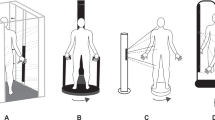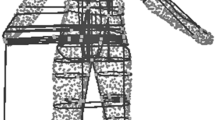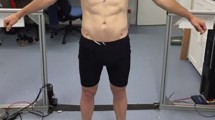Abstract
Background/Objectives
Three-dimensional optical (3DO) imaging systems that rapidly and accurately provide body shape and composition information are increasingly available in research and clinical settings. Recently, relatively low-cost and space efficient 3DO systems with the ability to report and track individual assessments were introduced to the consumer market for home use. This study critically evaluated the first 3DO imaging device intended for personal operation, the Naked Body Scanner (NBS), against reference methods.
Participants/Methods
Circumferences at six standardized anatomic sites were measured with a flexible tape in 90 participants ranging in age (5–74 years), ethnicity, and adiposity. Regression analysis and Bland-Altman plots compared these direct measurements and dual-energy X-ray absorptiometry (DXA) %fat estimates to corresponding NBS values. Method precision was analyzed from duplicate anthropometric and NBS measurements in a subgroup of 51 participants.
Results
The NBS exhibited greater variation in test–retest reliability (CV, 0.4–2.7%) between the six measured anatomic locations when compared with manually measured counterparts (0.2–0.4%). All six device-derived circumferences correlated with flexible tape references (R2s, 0.84–0.97; p < 0.0001). Measurement bias was apparent for three anatomic sites while mean differences were present for five. The NBS’s %fat estimates also correlated with DXA results (R2 = 0.73, p < 0.0001) with no significant bias.
Conclusions
This system opens a new era of digital home-based assessments that can be incorporated into weight loss or exercise interventions accessible to clinical investigators as well as individual users.
This is a preview of subscription content, access via your institution
Access options
Subscribe to this journal
Receive 12 print issues and online access
$259.00 per year
only $21.58 per issue
Buy this article
- Purchase on Springer Link
- Instant access to full article PDF
Prices may be subject to local taxes which are calculated during checkout



Similar content being viewed by others
References
FerroLuzzi A, et al. Physical status: the use and interpretation of anthropometry - Introduction. Who Tech Rep Ser. 1995;854:1–3.
Heymsfield SB, Stevens J. Anthropometry: continued refinements and new developments of an ancient method. Am J Clin Nutr. 2017;105:1–2.
Himes JH. Anthropometric assessment of nutritional status. New York: Wiley-Liss; 1991. xi, 431 p.
Cameron N. The Measurement of Human Growth. London: Croom Helm; 1984.
Madden AM, Smith S. Body composition and morphological assessment of nutritional status in adults: a review of anthropometric variables. J Hum Nutr Diet. 2016;29:7–25.
Ulijaszek SJ, Mascie-Taylor CGN. Anthropometry: the individual and the population. 1st edn. Cambridge: Cambridge University Press; 1994.
Frisancho AR. Anthropometric standards for the assessment of growth and nutritional status. Ann Arbor: University of Michigan Press; 1990.
Roche AF, Mukherjee D, Guo SM, Moore WM. Head circumference reference data: birth to 18 years. Pediatrics. 1987;79:706–12.
Paxton A, et al. Anthropometric equations for studying body fat in pregnant women. Am J Clin Nutr. 1998;67:104–10.
Piers LS, et al. Changes in energy expenditure, anthropometry, and energy intake during the course of pregnancy and lactation in well-nourished Indian women. Am J Clin Nutr. 1995;61:501–13.
Braganca S, Arezes PM, Carvalho M. An overview of the current three dimensional body scanners for anthropometric data collection. In: Arezes PM, Baptista JS, Barroso MP, Carneiro P, Cordeiro P, Costa N, et al., editors. Occupational safety and hygiene III. London: CRC Press: Taylor & Francis Group; 2015. p. 149–54.
Ling Y, et al. Rational and design of an overfeeding protocol in constitutional thinness: Understanding the physiology, metabolism and genetic background of resistance to weight gain. Ann Endocrinol (Paris). 2016;77:563–9.
Soileau L, et al. Automated anthropometric phenotyping with novel Kinect-based three-dimensional imaging method: comparison with a reference laser imaging system. Eur J Clin Nutr. 2016;70:475–81.
Xie B, et al. Accurate body composition measures from whole-body silhouettes. Med Phys. 2015;42:4668–77.
de Groot LC, Sette S, Zajkas G, Carbajal A, Amorim JA. Nutritional status: anthropometry. Euronut SENECA investigators. Eur J Clin Nutr. 1991;45(Suppl 3):31–42.
Lohman TG, Roche AF, Martorell R. Anthropometric standardization reference manual. Champaign, IL: Human Kinetics Books; 1988.
Bourgeois B, et al. Clinically applicable optical imaging technology for body size and shape analysis: comparison of systems differing in design. Eur J Clin Nutr. 2017;71:1329–35.
Centers for Disease Control and Prevention (CDC), National Center for Health Statistics (NCHS). National Health and Nutrition Examination Survey (NHANES): Anthropometry Procedures Manual. Hyattsville, MD: Centers for Disease Control and Prevention; 2007.
Lu Y, et al. Dual X-ray absorptiometry quality control: comparison of visual examination and process-control charts. J Bone Min Res. 1996;11:626–37.
Gluer CC, Blake G, Lu Y, Blunt BA, Jergas M, Genant HK. Accurate assessment of precision errors: how to measure the reproducibility of bonedensitometry techniques. Osteoporos Int.1995;5:262–70.
Acknowledgements
The authors thank Shape Up! Adults and Shape Up! Kids participants and parents for the time and enthusiasm they contributed to this study. In addition, this work could not have been completed without the assistance, data, and cooperation from Samantha Winter, Thomas Ward, and Bennett Ng at Naked Labs as well as formatting assistance from Melanie Peterson at Pennington Biomedical Research Center.
Funding
This work was partially supported by two National Institutes of Health NORC Center Grants P30DK072476, Pennington/Louisiana; and P30DK040561, Harvard; and R01DK109008, Shape UP! Adults.
Author information
Authors and Affiliations
Contributions
S.K., P.H., J.A.S., and S.B.H. analyzed the data and drafted the paper; S.K., P.H., J.A.S., and S.B.H. designed the study; S.K., P.H., and S.B.H. directed implementation and data collection; S.K., P.H., Y.E.L., and N.K. collected the data; J.A.S. and S.B.H. provided necessary logistical support; S.K., P.H., Y.E.L., N.K., S.S., J.A.S., and S.B.H. edited the paper for intellectual content and provided critical comments on the paper.
Corresponding author
Ethics declarations
Conflict of interest
The authors declare that they have no conflict of interest.
Additional information
Publisher’s note Springer Nature remains neutral with regard to jurisdictional claims in published maps and institutional affiliations.
Supplementary information
Rights and permissions
About this article
Cite this article
Kennedy, S., Hwaung, P., Kelly, N. et al. Optical imaging technology for body size and shape analysis: evaluation of a system designed for personal use. Eur J Clin Nutr 74, 920–929 (2020). https://doi.org/10.1038/s41430-019-0501-2
Received:
Revised:
Accepted:
Published:
Issue Date:
DOI: https://doi.org/10.1038/s41430-019-0501-2
This article is cited by
-
Mobile phone applications for 3-dimensional scanning and digital anthropometry: a precision comparison with traditional scanners
European Journal of Clinical Nutrition (2024)
-
Silhouette images enable estimation of body fat distribution and associated cardiometabolic risk
npj Digital Medicine (2022)
-
Digital anthropometric evaluation of young children: comparison to results acquired with conventional anthropometry
European Journal of Clinical Nutrition (2022)



